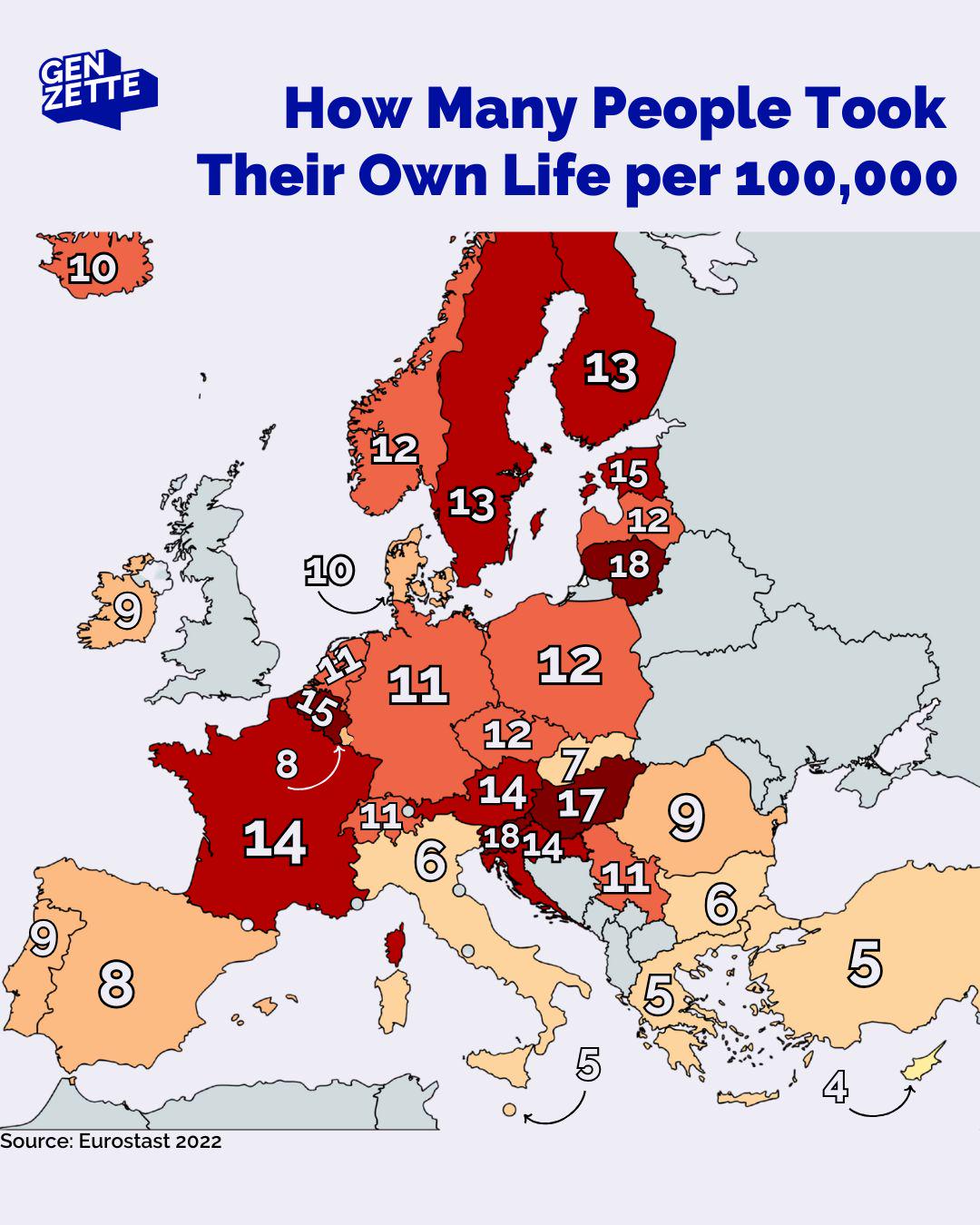Suicide Rate Map 2022 Per 100,000 People


David Chen
Data Visualization Specialist
David Chen is an expert in transforming complex geographic datasets into compelling visual narratives. He combines his background in computer science ...
Geographic Analysis
What This Map Shows
This map visualizes the suicide rates across different countries in 2022, represented as the number of deaths by suicide per 100,000 people. Each country is color-coded to indicate the severity of this tragic issue, allowing viewers to quickly grasp the global landscape of mental health challenges. The data reflects a complex interplay of cultural, social, and economic factors that contribute to these rates, making it a poignant illustration of a pressing public health crisis.
Deep Dive into Suicide Rates
Suicide is a multifaceted issue that affects individuals and communities worldwide. Globally, it is a leading cause of death, particularly among young adults aged 15-29. The World Health Organization (WHO) estimates that over 700,000 people die from suicide each year, underscoring the urgency of addressing mental health issues. Interestingly, suicide rates can vary significantly between different regions and demographics, influenced by a variety of factors including mental health support, social acceptance, and economic conditions.
One intriguing aspect is the stigma that surrounds mental health issues, which can deter individuals from seeking help. Countries with better mental health infrastructure and more open discussions around mental health tend to have lower suicide rates. For instance, Scandinavian countries often report lower rates, partly due to their comprehensive social safety nets and widespread mental health services.
On the other hand, regions with limited access to mental health care often struggle with higher rates of suicide. Countries in Eastern Europe, for example, have some of the highest suicide rates globally, linked to economic hardship and social isolation. The contrast is stark when compared to nations like Japan or South Korea, where, despite high rates of academic and professional pressures, there has been a significant investment in raising awareness and resources for mental health.
Moreover, socio-economic factors play a crucial role. The correlation between unemployment rates and suicide is well-documented; during economic downturns, suicide rates often spike. Interestingly, in some cultures, the pressure to succeed can create immense stress, leading to a rise in suicide, especially among young people. It raises a crucial question: how do we balance societal expectations with mental health needs?
Understanding these dynamics is vital for developing effective prevention strategies. By addressing the root causes of suicide—such as poverty, lack of education, and social stigma—countries can create a more supportive environment that encourages individuals to seek help.
Regional Analysis
When analyzing the map, it becomes evident that there are distinct regional trends in suicide rates. For instance, in North America, the rates vary between the United States and Canada. The United States exhibits higher rates, particularly in rural areas where access to mental health care is limited. In contrast, Canada’s more robust healthcare system and proactive mental health policies contribute to lower rates.
In contrast, the map highlights alarming trends in parts of Asia, especially in countries like South Korea and Japan, where societal pressures are pronounced. South Korea has been grappling with high suicide rates, often attributed to academic stress and a demanding work culture. Interestingly, recent initiatives to promote mental well-being have shown positive results, indicating that change is possible.
Conversely, many African nations report lower overall suicide rates, but this can be misleading. Underreporting due to stigma or lack of data collection can mask the true extent of the issue. For example, in some regions, traditional beliefs may lead to misclassification of suicide, further complicating our understanding of the problem.
Significance and Impact
The significance of understanding suicide rates cannot be overstated. It directly ties to public health, social stability, and economic productivity. High suicide rates can indicate underlying societal issues, such as inadequate mental health resources or pervasive social stigma. Addressing these issues is essential not just for reducing the rates, but also for fostering healthier communities.
Moreover, as we look to the future, trends indicate a need for increased awareness and proactive strategies. With the rise of digital communication, there’s potential for both positive and negative impacts on mental health. Social media can foster community and support, but it can also exacerbate feelings of isolation and inadequacy.
In conclusion, the suicide rate map for 2022 serves as a critical reminder of the ongoing challenges many face regarding mental health. By engaging with this data, we equip ourselves to advocate for better mental health resources and support systems, paving the way for a future where fewer lives are lost to suicide. The conversation around mental health must continue, as every statistic represents a life—a reminder that we must work collectively towards solutions that embrace understanding, compassion, and support.
Visualization Details
- Published
- October 8, 2025
- Views
- 18
Comments
Loading comments...